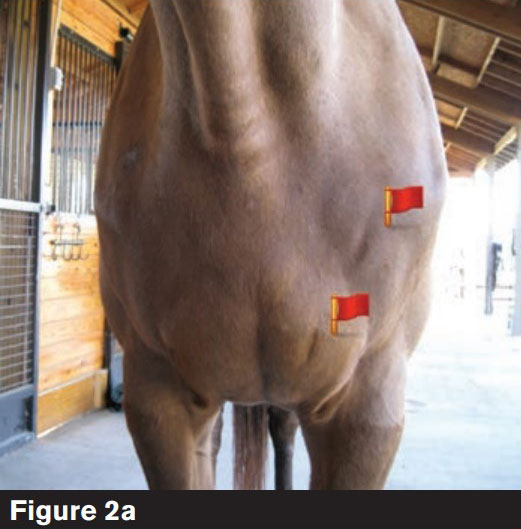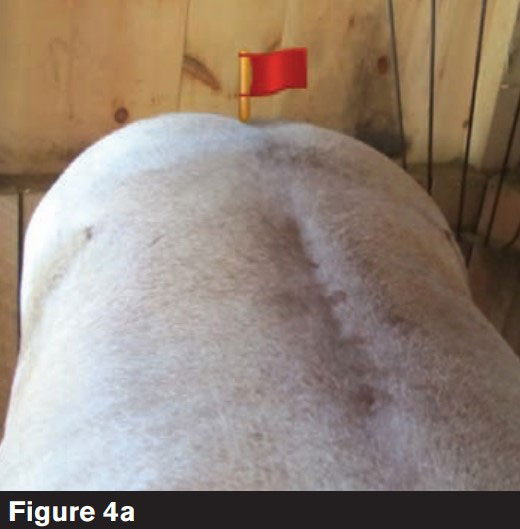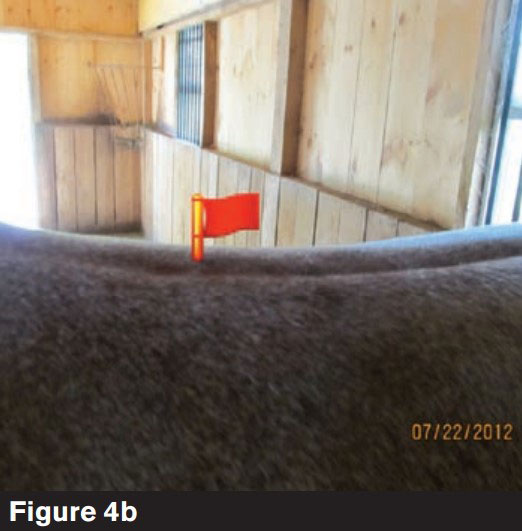Old injuries might be healed, but residual pain can affect body language, attitude and performance
By Heather Smith Thomas,
Contributing Writer
Before properly shoeing a horse, its conformation must be assessed to know how best to balance the feet. Yet, before conformation can be evaluated the horse must be standing squarely on all four feet. Thus, posture makes a huge difference, and a farrier must be able to tell the difference between conformation and posture.
There are a number of “red flags” that farriers can look for to help determine the difference, Dr. Patricia Bona told attendees at the 2018 International Hoof-Care Summit in Cincinnati, Ohio.
These red flags are myofascial restriction sites that are the result of trauma. Although they appear to be “dings,” they are more than just cosmetic blemishes.
Myofascial tissue is the thin, strong, fibrous connective tissue that provides support and protection for muscles and bones. When damaged, they might affect the horse’s comfort and posture — and
this asymmetry can affect the outcome of the farrier’s work.
“It’s called horseshoeing, not hoof shoeing,” says the Blue Bell, Pa., equine
and human chiropractor. “As farriers, you focus a lot on the foot but your work helps the whole horse.”
POSTURE IMBALANCES
When assessing conformation, farriers are looking at skeletal structure, such as the length of certain bones, bone shape and size, proportions, angles, etc. Posture is the variable, affecting symmetry and how the skeletal framework is arranged. The horse looks quite different standing foursquare than when standing camped out, camped under, slouching, etc.
Although a horse’s conformation cannot be changed, it can help change its comfort and posture, as well as the biomechanics of movement.
“Good posture is the foundation for optimum biomechanics,” Bona explains. “Good posture supports proper joint alignment and range of motion. Joints must move properly for adequate lubrication and nutrients; if the joints aren’t used properly, they get stiff and uncomfortable.”
Good posture reduces stress and strain on soft tissues and minimizes wear and tear on the joints, she says.
“The foundation for good posture starts at the feet, and the optimum support for good posture is for the horse to be standing easily foursquare with all four cannon bones on the vertical. That’s just good physics,” Bona explains. “There is a less negative effect from gravity, and less stress and strain on any one joint or body part.”
A farrier must be able to assess and address posture imbalances and check for asymmetries. For example, a horse that stands with its chest and shoulders over its front feet (Figure 1) will put more strain on suspensory ligaments, flexor tendons, sesamoid bones, fetlock joint, pastern and coffin bone. It’s a posture
that will either create or perpetuate long toe/low heel syndrome. The horse also is standing too straight in the hocks and stifles in an attempt to counterbalance the bad posture in front.
It’s important to also assess the horse’s skin and body contours for myofascial imbalances. Any dent, scar, bubble, flat spot, irregularity in contour, etc. should raise a red flag for the farrier, Bona says.
“A red flag is when you approach a horse that has a big crease in his back and he’s head high,” she says. “His posture is telling you he’s in fight or flight. We need to look at these things and take them seriously.”
A scar might be from a rope burn, wire cut, sutured wound, kick from another horse, running into a door or fence, etc. White hairs signify trauma of some kind that created disruption of hair follicles.
FARRIER TAKEAWAYS
- Myofascial restrictions, which can appear to be dents or dings, are often
more than just cosmetic. - These restrictions are red flags that can indicate when a horse has poor
posture as a result of injury compensation. - A dent or restriction in the hamstring muscle or shoulder can negatively
affect posture and weight bearing.
PREVIOUS TRAUMA
Many generally think an old injury or blemish is just cosmetic or not important. However, each of these dings and dents has a history, and some of them need to be addressed.
“I can’t tell you how many times I see a dent and I ask the owner, ‘How long have they had that dent,’” Bona says. “They usually say one of two things. They either don’t even see it or they have wondered what it was, but they never asked anybody because they might have been told it was cosmetic. It’s just there. It’s not pretty, but it’s no big deal.”
In reality, though, some of the dings, dents and scars indicate a site of previous trauma that might have sustained a deeper injury that can affect posture and mechanics. They might be healed on the outside, with deeper scars, adhesions or restrictions that cause insidious compensations in posture and gait.
“You want to get in there and palpate it,” she says. “It can feel nodular. It can feel like baling twine. It can feel like a little pea. That’s the scar tissue because there was so much trauma to the muscles that it was reabsorbed, became a defect
and now it’s second-class tissue. We need to see how that’s going to affect and cause compensation in the posture by the symmetry, the gait, the soundness of the horse and the hoof balance itself.”
Bona points out that scar tissue might be a mechanical restriction affecting movement, symmetry and balance, or it can cause restrictions in movement because of pain from that area.
“It just depends on how that horse’s nervous system is wired,” she says. “Sometimes it can be an actual mechanical restriction due to trigger points that can have referred pain.”
In one case, a horse’s owner informed Bona that the horse was having problems jumping and galloping. Upon inspection, the horse had two dents on its left shoulder (Figure 2a).
“Both feet are turned to the right (Figure 2b),” she says. “Guess what? It’s not both front feet. It’s the front feet and the shoulders that have turned. Is that poor posture or is that poor conformation? It’s poor posture because the red flag is the dent across the horse’s shoulder and into the chest.”
Bona explains that the former injury probably caused bruising and swelling. As it abates, the owner often mistakenly believes that the situation is fine.
“Over the next 2 or 3 months, that tissue starts to compensate and that horse’s foot starts to rotate in,” she says. “In this case, the foot rotates out because we have to work and function in gravity. That’s compensation. It’s pretty profound.”
A dent in the shoulder from an old injury will affect the brachiocephalicus muscle. Bona points out that it goes all the way up across the cervical vertebrae, with fascial integration up into the back of the jaw.
“When there’s a dent in the shoulder, you might see a tightening of the throatlatch and a compression onto the cervical spine,” she says. “It will affect the shoulder, the elbow, and often reflect back up into the withers and cause a flat spot in the withers. A dent in the shoulder or any area up on the neck will have the same effect because that fascial tissue and muscle mass is intimately connected and will all be influenced.”
A dent or restriction in the buttock or hamstring muscle can change the angle of the hind leg. That muscle attaches up in the sacrum, goes to the point of the buttocks and all the way down into the stifle and hock.
Dents and dings at the point of the buttocks or shoulder (Figures 3a and 3b) can cause significant distortion in the alignment of the hips and shoulder blades. This can negatively impact posture and weight bearing.
Simply pulling a front leg forward to place the foot on a hoof stand can cause pain or discomfort in a horse that has this type of injury.
“That dent also changes because it is in the fascial tissue in the supraspinatus muscle, and affects the horse’s whole neck,” Bona says. “He might not be able to stand comfortably to shoe. He might pull that foot forward, or maybe the right hind foot. These are the kinds of things that will affect the process and outcome of your work.”
The foundation for good posture starts at the feet …
CREASED BACK
If a horse is in pain, it changes its posture and movement. If it’s tense, it might actually have a crease in its back (Figures 4a and 4b) that wouldn’t exist if it were relaxed.
“A creased back is not always a fat back,” she says. “Fat jiggles, but a tense back isn’t jiggling. You need to recognize that it might create a problem with the outcome in your shoeing.”
Bona reminds farriers to look at the whole horse and not just focus on feet or legs.
“What is the fluid dynamics of that horse’s skin telling you as it’s standing there and while it’s moving?” she asks.
“Fluid dynamics is when the s k i n m o v e s f r e e l y o v e r every body part and bony protuberance of the horse.”
If the horse can be made more comfortable, which might take a combination of chiropractic work and good farriery, it may be able to stand square again, she says.
Body language and posture, attitude (cranky, ticklish, girthy, etc.), dents and dings, can all be clues that something is not right with a horse. A farrier needs to figure out how to help make that horse become more comfortable so it can stand foursquare on the vertical.
** RED FLAGS FOR FARRIERS







